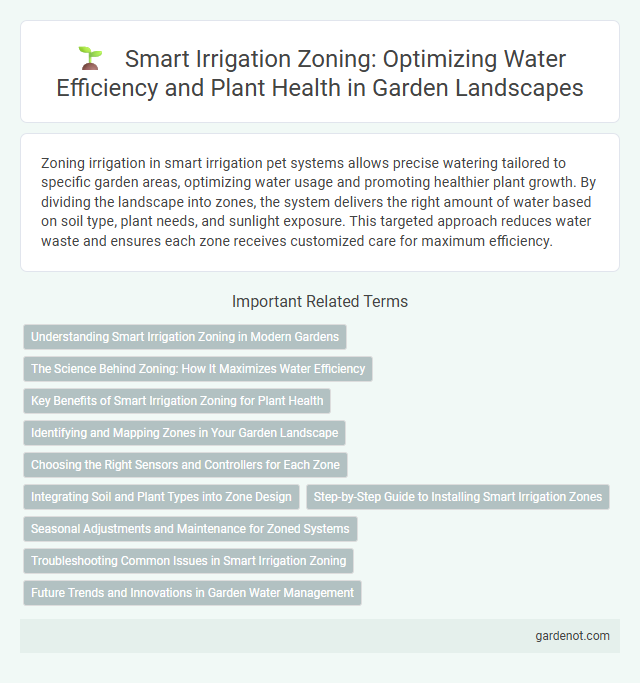Zoning irrigation in smart irrigation pet systems allows precise watering tailored to specific garden areas, optimizing water usage and promoting healthier plant growth. By dividing the landscape into zones, the system delivers the right amount of water based on soil type, plant needs, and sunlight exposure. This targeted approach reduces water waste and ensures each zone receives customized care for maximum efficiency.
Understanding Smart Irrigation Zoning in Modern Gardens
Smart irrigation zoning enhances water efficiency by dividing gardens into distinct zones based on specific plant types, soil conditions, and sunlight exposure. Each zone receives tailored watering schedules and volumes, optimizing hydration and minimizing waste across varied landscapes. Advanced controllers adjust irrigation dynamically through sensors and weather data, ensuring precise water delivery aligned with real-time environmental needs.
The Science Behind Zoning: How It Maximizes Water Efficiency
Zoning irrigation divides landscapes into distinct sections, allowing precise control over water distribution based on specific plant and soil needs. This targeted watering approach leverages soil moisture sensors and evapotranspiration data to deliver optimal hydration, reducing water waste. By tailoring irrigation schedules and volumes for each zone, this method significantly enhances water efficiency and promotes healthier plant growth.
Key Benefits of Smart Irrigation Zoning for Plant Health
Smart irrigation zoning precisely delivers water tailored to specific plant needs, enhancing nutrient uptake and reducing water stress. By segmenting landscapes into zones based on soil type, plant species, and sun exposure, it prevents overwatering and underwatering, promoting healthier root systems. This targeted approach minimizes disease risk and optimizes growth, resulting in more resilient and vibrant plants.
Identifying and Mapping Zones in Your Garden Landscape
Identifying and mapping zones in your garden landscape is essential for smart irrigation efficiency. Segment your garden based on plant types, soil conditions, and sunlight exposure to tailor watering schedules and prevent over- or under-watering. Creating precise irrigation zones maximizes water conservation and promotes healthier plant growth by delivering targeted moisture where it's needed most.
Choosing the Right Sensors and Controllers for Each Zone
Selecting the right sensors and controllers for each irrigation zone ensures precise water delivery tailored to soil type, plant species, and sunlight exposure. Advanced soil moisture sensors and weather-based controllers optimize irrigation schedules, reducing water waste and promoting healthy plant growth. Integrating zone-specific technology enhances system efficiency and supports sustainable landscape management.
Integrating Soil and Plant Types into Zone Design
Zoning irrigation by integrating soil and plant types enhances water efficiency by delivering precise moisture tailored to specific vegetation and soil absorption rates. Different soil textures, such as sandy or clay, influence water retention, while plant species have varying water needs that zoning accounts for to optimize irrigation schedules. This targeted approach reduces water waste, promotes healthy plant growth, and supports sustainable landscape management.
Step-by-Step Guide to Installing Smart Irrigation Zones
Creating smart irrigation zones begins with mapping your landscape to identify areas with similar water needs, ensuring efficient watering. Install separate irrigation valves for each zone and connect them to a smart controller that allows individualized scheduling and moisture monitoring. Calibrate each zone based on soil type and local weather data to optimize water use and promote healthier plant growth.
Seasonal Adjustments and Maintenance for Zoned Systems
Zoning irrigation systems require regular seasonal adjustments to optimize water distribution based on varying plant water needs and weather conditions throughout the year. Proper maintenance, including checking valves, sensors, and controllers, ensures each zone operates efficiently and prevents overwatering or underwatering. Implementing smart sensors and weather-based controllers enhances the precision of watering schedules for each zone, reducing water waste and promoting healthy plant growth.
Troubleshooting Common Issues in Smart Irrigation Zoning
Troubleshooting common issues in smart irrigation zoning involves addressing zone valve malfunctions, inconsistent water pressure, and sensor calibration errors. Ensuring each zone's controller communicates effectively with moisture sensors helps optimize water distribution and prevents overwatering or dry spots. Regular inspection for system leaks, clogged emitters, and software updates enhances zoning accuracy and irrigation efficiency.
Future Trends and Innovations in Garden Water Management
Zoning irrigation systems are evolving with smart sensors and AI-driven analytics to optimize water distribution based on soil moisture, plant type, and weather forecasts. Emerging innovations include integrating IoT devices for real-time monitoring and adaptive irrigation scheduling that reduces water waste and enhances garden health. Future trends emphasize sustainability through automated leak detection, precision water delivery, and AI-powered predictive maintenance, revolutionizing garden water management.
Zoning irrigation Infographic

 gardenot.com
gardenot.com